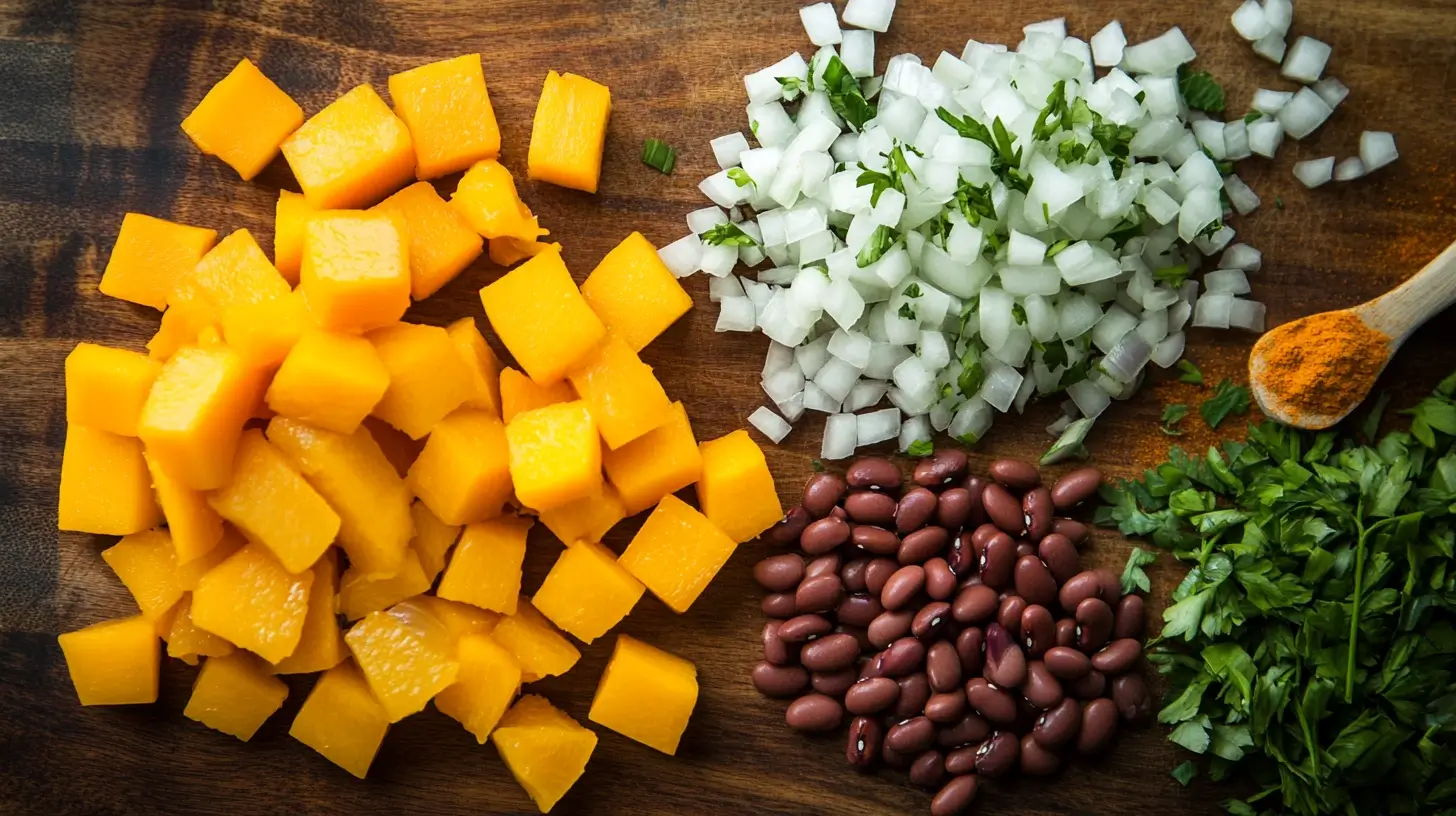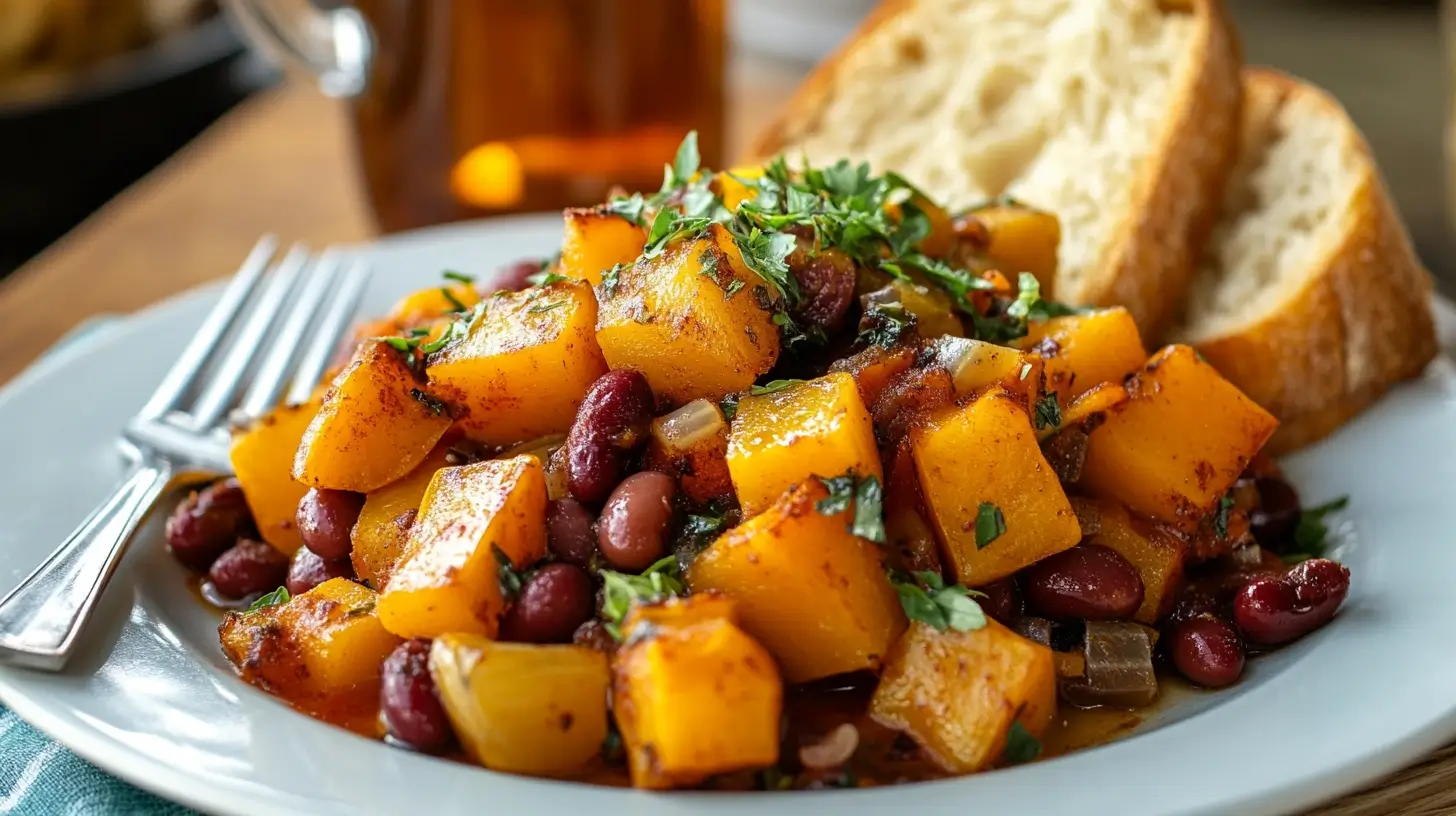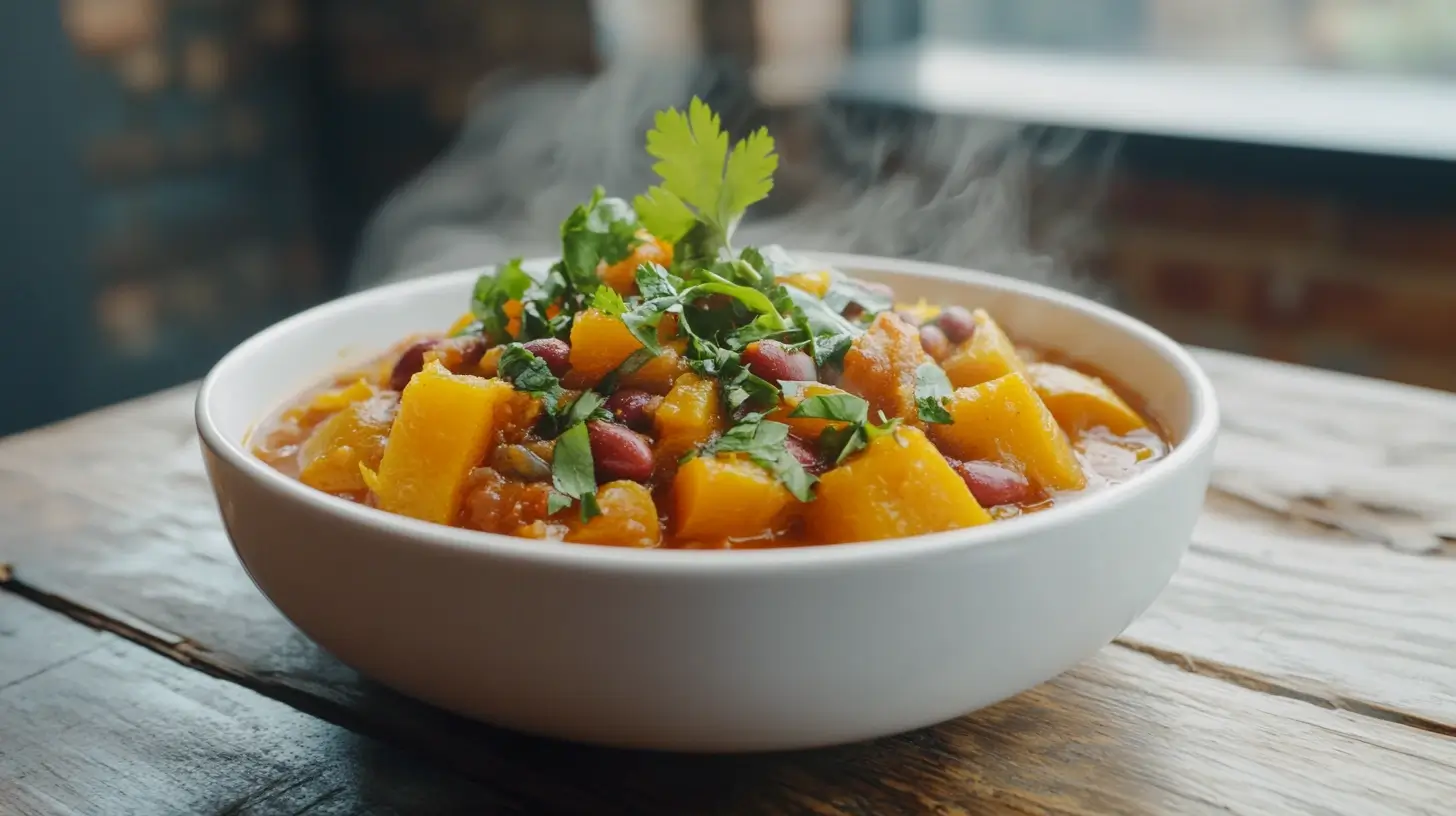This guide walks you through the delightful world of recipe squash and kidney beans. Packed with nutrients, flavor, and endless possibilities, this recipe isn’t just food—it’s comfort in a bowl. From preparation to serving, and even troubleshooting common issues, we’ve got all the details covered. Let’s dive right in!
Why Choose Squash and Kidney Beans?
Let’s be real—sometimes, meal planning feels like a chore. But that’s where squash and kidney beans come to the rescue. This combo isn’t just tasty; it’s a powerhouse of nutrition. Squash, with its natural sweetness and tender texture, complements the hearty, protein-packed kidney beans perfectly. Whether you’re after a comforting family dinner or an easy way to boost your veggie intake, this recipe ticks all the boxes.
Plus, squash and kidney beans are versatile. You can whip them into soups, stews, or even casseroles. They fit a variety of diets, including vegan and gluten-free options, and are a hit with picky eaters.
The Nutritional Value of Squash and Kidney Beans
Why should you care about nutrition? Because good food equals good energy! Kidney beans are a fantastic source of plant-based protein, fiber, and essential minerals like iron and potassium. Meanwhile, squash is loaded with vitamins A and C, which are great for your skin and immune system. Together, they create a meal that’s not just filling but genuinely good for you.
Here’s a quick breakdown:
| Nutrient | Squash | Kidney Beans |
|---|---|---|
| Calories | Low | Moderate |
| Protein | Low | High |
| Fiber | High | Very High |
| Vitamins & Minerals | Vitamin A, Vitamin C | Iron, Potassium, Folate |
With benefits like these, who wouldn’t want to add squash and kidney beans to their weekly menu?
Ingredients and Preparations
Key Ingredients for the Recipe
To create a delicious recipe of squash and kidney beans, you’ll need the following ingredients:
- Butternut Squash: 1 medium-sized, peeled and diced.
- Kidney Beans: 2 cups, cooked or canned, drained and rinsed.
- Onion: 1 large, finely chopped.
- Garlic: 3 cloves, minced.
- Tomatoes: 2 large, chopped, or 1 can (14.5 oz) of diced tomatoes.
- Vegetable Broth: 2 cups.
- Olive Oil: 2 tablespoons.
- Spices:
- Cumin: 1 teaspoon.
- Paprika: 1 teaspoon.
- Chili Powder: 1 teaspoon.
- Salt and Pepper: to taste.
- Fresh Herbs:
- Cilantro or Parsley: for garnish.

These ingredients come together to form a hearty and nutritious dish that’s perfect for any meal.
How to Select the Best Squash and Beans at the Market
Choosing quality produce is essential for the best flavor and texture. When selecting a butternut squash:
- Appearance: Look for a squash with a uniform beige color and no green patches.
- Texture: The skin should be firm and free of soft spots or blemishes.
- Weight: It should feel heavy for its size, indicating a dense, ripe squash.
For kidney beans:
- Dried Beans: Ensure they are uniform in size and color, without any cracks or shriveled surfaces.
- Canned Beans: Opt for cans without dents or bulges, and check the expiration date. Low-sodium options are preferable for better control over seasoning.
Essential Kitchen Tools You’ll Need
Having the right tools on hand makes preparation smoother:
- Chef’s Knife: For chopping vegetables.
- Cutting Board: A sturdy surface for prepping ingredients.
- Large Pot or Dutch Oven: Ideal for cooking the stew evenly.
- Wooden Spoon: For stirring without scratching your cookware.
- Measuring Spoons and Cups: To ensure accurate measurements of spices and liquids.
With these tools and ingredients ready, you’re all set to start cooking your squash and kidney beans recipe.
Step-by-Step Cooking Instructions
Preparing the Squash
- Peeling: Using a vegetable peeler, remove the skin of the butternut squash.
- Seeding: Cut the squash in half lengthwise and scoop out the seeds with a spoon.
- Dicing: Chop the squash into 1-inch cubes for even cooking.
Prepping and Cooking the Kidney Beans
If using dried kidney beans:
- Soaking: Place the beans in a large bowl and cover with water. Soak overnight or use the quick-soak method by boiling for 2 minutes, then letting them sit for an hour.
- Cooking: Drain and rinse the soaked beans. In a pot, cover them with fresh water and bring to a boil. Reduce heat and simmer for 45 minutes to an hour, until tender.
If using canned beans:
- Rinsing: Drain the beans in a colander and rinse under cold water to remove excess sodium and preservatives.
Combining Flavors: Bringing the Dish Together
- Sautéing Aromatics:
- In a large pot or Dutch oven, heat olive oil over medium heat.
- Add chopped onions and cook until translucent, about 5 minutes.
- Add minced garlic and cook for an additional minute, stirring frequently.
- Adding Spices:
- Stir in cumin, paprika, and chili powder, allowing them to toast slightly to release their flavors.
- Incorporating Squash and Tomatoes:
- Add the diced butternut squash and chopped tomatoes (or canned tomatoes) to the pot.
- Pour in the vegetable broth, stirring to combine all ingredients.
- Simmering:
- Bring the mixture to a boil, then reduce heat to low.
- Cover the pot and let it simmer for 20-25 minutes, or until the squash is tender.
- Adding Kidney Beans:
- Stir in the cooked or canned kidney beans.
- Continue to simmer for an additional 10 minutes, allowing the flavors to meld together.
Cooking Tips to Avoid Common Mistakes
- Avoid Overcooking the Squash: Keep an eye on the squash to prevent it from becoming too soft and losing its shape.
- Seasoning: Taste the stew before serving and adjust the salt and pepper as needed. Remember, it’s easier to add more seasoning than to fix an over-salted dish.
- Consistency: If the stew is too thick, add a bit more vegetable broth. If it’s too thin, let it simmer uncovered to reduce the liquid.
By following these steps, you’ll create a flavorful and satisfying squash and kidney beans recipe that’s sure to impress.
Customizing the Recipe for Dietary Needs
Making It Vegan or Vegetarian-Friendly
Good news! This recipe for squash and kidney beans is naturally vegan and vegetarian. It contains plant-based ingredients that provide essential nutrients without any animal products. The combination of squash and kidney beans offers a hearty and satisfying meal suitable for those following a vegan or vegetarian diet.
Adding Protein for Non-Vegetarians
If you’re looking to increase the protein content, consider adding lean meats. For instance, diced chicken breast or turkey can complement the flavors of squash and kidney beans. Simply sauté the meat until fully cooked, then incorporate it during the final simmering stage. This addition not only boosts protein but also adds a different texture to the dish.
Low-Sodium and Heart-Healthy Adjustments
To make this dish heart-healthier, opt for low-sodium or no-salt-added canned kidney beans and vegetable broth. Additionally, reduce the amount of added salt and rely more on herbs and spices to enhance flavor. Incorporating fresh vegetables and using healthy fats, like olive oil, can further contribute to a nutritious meal.
For more delicious recipes, check out our The Ultimate Burger Bowl Recipe
Serving Suggestions and Pairings
Best Side Dishes to Serve with Squash and Kidney Beans
Pairing this squash and kidney beans recipe with the right side dishes can elevate your meal. Consider serving it alongside steamed rice or quinoa to soak up the flavorful sauce. A fresh green salad with a light vinaigrette can add a crisp contrast to the hearty stew. Additionally, warm, crusty bread is perfect for dipping and complements the dish well.

Beverage Pairings to Elevate the Meal
Choosing the right beverage can enhance your dining experience. For a non-alcoholic option, a chilled glass of sparkling water with a splash of lemon provides a refreshing balance. If you prefer wine, a light-bodied red, such as Pinot Noir, pairs nicely without overpowering the flavors of the squash and kidney beans. Alternatively, a crisp white wine like Sauvignon Blanc can offer a pleasant contrast.
Common Problems and Solutions
What If the Squash Turns Mushy?
Sometimes, squash can become too soft while cooking. To avoid this, try the following:
- Cut Uniform Pieces: Chop the squash into evenly sized cubes. This ensures they cook at the same rate.
- Don’t Overcook: Keep an eye on the cooking time. Squash only needs about 10–15 minutes to become tender.
- Add Late: If the recipe involves a long simmer, add the squash during the final stages to prevent it from breaking apart.
If the squash does turn mushy, don’t worry. You can blend a portion of the dish to create a creamy base and salvage the texture.
Troubleshooting Kidney Beans: Overcooked or Undercooked
Kidney beans can be tricky, especially when cooking from scratch. Here’s how to handle common issues:
- Overcooked Beans: If the beans are too soft, add them later in the recipe to retain their shape. Overcooking happens quickly, so check them often during boiling.
- Undercooked Beans: Hard beans can ruin the dish. Soak them overnight to shorten cooking time, and simmer until tender before adding to the squash mixture.
For canned beans, always rinse them to remove excess sodium and ensure they integrate smoothly into your recipe.
Balancing Flavors: Too Bland or Overpowering?
A common issue when making a recipe with squash and kidney beans is getting the seasoning just right.
- Too Bland: Add a pinch of salt, a dash of vinegar, or a squeeze of lemon juice to brighten the flavors. Fresh herbs like cilantro can also help.
- Too Strong: If spices dominate the dish, stir in a dollop of yogurt or coconut milk to mellow the intensity. You can also dilute the dish with extra vegetable broth.
Storage and Reheating Tips
Properly Storing Leftovers
To keep your squash and kidney beans recipe fresh, follow these storage tips:
- Cool First: Let the dish cool to room temperature before transferring it to storage containers.
- Use Airtight Containers: This prevents moisture loss and keeps odors from mixing in the fridge.
- Refrigeration: Store in the fridge for up to 3–4 days.
For longer storage, freeze portions in freezer-safe containers. Label them with the date to keep track of freshness.
Reheating Without Losing Flavor or Texture
Reheating this dish is simple, but there are a few tricks to maintain its taste and texture:
- On the Stove: Heat gently in a pot over low to medium heat. Add a splash of vegetable broth if it seems too thick.
- In the Microwave: Reheat in short intervals, stirring occasionally to ensure even heating.
- Frozen Portions: Thaw in the fridge overnight before reheating for the best results.
Leftovers are perfect for quick meals or lunch on the go. This dish often tastes even better the next day as the flavors meld together!
FAQs
Can I Freeze the Cooked Dish?
Absolutely! Freezing your recipe squash and kidney beans is a great way to save leftovers for later. To do this:
- Cool Completely: Make sure the dish is at room temperature before freezing.
- Portion It Out: Divide the meal into individual servings for easy reheating.
- Freeze in Airtight Containers: This prevents freezer burn and preserves flavor.
Frozen portions can last up to three months. When ready to eat, thaw them in the fridge overnight and reheat on the stove or in the microwave.
How Long Can I Store the Leftovers?
In the fridge, your squash and kidney beans recipe can be safely stored for 3–4 days. Always use a sealed container to keep the dish fresh and prevent unwanted odors. If you can’t finish it in time, freezing is the best option to avoid waste.
What Other Beans Work Well in This Recipe?
While kidney beans are a classic choice, you can swap them for other legumes depending on what you have. Black beans, chickpeas, or pinto beans work beautifully in this dish. Each type brings its unique texture and taste, making the recipe adaptable to your preferences.
Can I Substitute Butternut Squash for Other Varieties?
Yes! Butternut squash is popular for its natural sweetness, but other varieties like acorn squash or even pumpkin can be used. If using a different squash, keep in mind that cooking times may vary slightly due to differences in texture.
Wrapping It Up: Why This Recipe Stands Out
The recipe squash and kidney beans combines simplicity, nutrition, and flavor in one dish. Whether you’re cooking for a weeknight dinner or prepping meals in advance, this recipe delivers every time. The hearty kidney beans and tender squash make it satisfying, while the spices add a comforting warmth. Plus, it’s incredibly versatile, fitting various dietary needs.
Share Your Creations and Feedback!
Now it’s your turn to give this recipe a try! Don’t forget to personalize it with your favorite spices or sides. If you enjoyed it, share your experience with friends and family. We’d love to hear how it turned out for you—leave a comment or share a photo on social media.
For more amazing recipes, explore other posts on our blog. Happy cooking!

